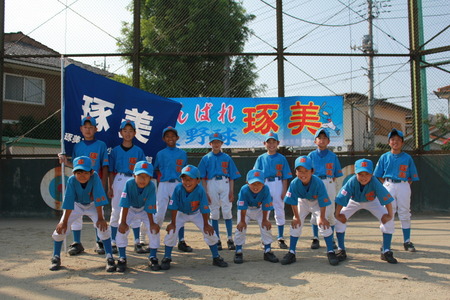
Fujifabric's "Kinen Shashin" is a song that a baseball boy looks at a souvenir photo, taken at parting, thinking back upon the past.
The lyrics written by Mr. Masahiko Shimura, and the music was composed by Mr. Shoichiro Yamauchi, the guitarist of Fujifabric.
Mr. Shimura, who played baseball in the school team, said in the interview, "writing a song on baseball as a theme is quite difficult.", but there are several Fujifaburic's songs about baseball, such as "Baseball Never Ends" in the 2nd album, "FAB FOX".
It was Mt. Shimura's style not to use the words which can limit the meaning of the lyrics, on purpose, - in another way, each listener can interpret the lyrics in his/her own way he/she wishes.
In the lyrics of "Kinen Shashin", it is not clearly stated that the person whom the scarf looks nice on, is a girl, but we can detect that it's meant to be a girl, can't we?
A young boy's transitory love!
The girl can be a "manager" of the team (the word, "manager" is used in a different way to English here.)
In a junior high and high school baseball team in Japan, there is a person, sometimes more than one, called "manager". The main job is to write the record on score board, to calculate the marks on the team in competitions, to keep an eye on players' condition, and so on.
It does not necessarily mean that all managers are girls, but it is often a female.
Only a few girls are in a big boys' team, and that situation promotes boys to fancy those girls - this conforms to the stereotype of Japanese student's life and is often found in Japanese cartoon comics ('Touch' is one of the famous ones.)
The boy in "Kinen Shashin" grows up and becomes a young man wistfully remembering old days when he was in the baseball team.
That girl parted after activity is finished...
In pauses of busy hardworking days with little stumbles, "I" think about "her" looking at the souvenir photo take on that day.
This song is again filled with the Japanese traditional worldview, which is a core of Fujifabric's songs - perceiving impermanence, an empathy towards change and a sensitivity of ephemera.

Please find the photo above taken in front of the sphinx in Giza in 1864 .
This is the souvenir photo of Ikeda Embassy consisting of 34 Samurai sent by Tokugawa Shogunate for the purpose of foreign affairs with European countries, and about 20 Samurai with topknot hair can be clearly seen on the photo.
Japanese were already enthusiastic about taking a souvenir photo standing in a row at the time a camera device was just imported from the west.
As you can observe in western caricatures, cartoons (such as "Popeye") and films (such as "Breakfast at Tiffany"), a Japanese is always a buck-toothed man with thick glasses hanging a camera down from his neck! It must be the image towards Japanese a half century ago.
Let's investigate the cultural background of the theory Japanese love to take photos.
In British schools, whole year groups and staff line up together and take a panoramic photo, called a school photo the end of every academic year.
Students in UK also take an individual photo, which is similar to the one on a student ID handbook in Japan.
A British, who has been inherited frontier spirits over centuries since the colonial period, is full of curiosity, and loves to travel around the world holding a knapsack on the back and a camera in one hand.
In spite of their nature, they hardly take a souvenir photo standing up in a raw at tourist spots.
It is my personal opinion this is deeply associated with the nature of Japanese - being fond of keeping a record.

In around the 8th century, officials, called Kokushi, were sent from central government to oversee a province. Kokushi held considerable power and responsibility over local people and the literates were obliged to write a record of events what happened in the province. A great amount of records written in each province still exists in Japan.
Recent studies show that those information on the diaries was so accurate that even world news, like earthquakes and Tsunami hit present Seattle, was clearly recorded .
Westerners were also surprised at the literacy rate of Japanese people in the Edo Era.
It was almost 0% of illiteracy in Japan.
Thanks to the development of a small private primary schools all over Japan, children had a chance to learn letters and abacus for numeracy. In terms of literacy, it is no comparison to the children in the West in 17th, 18th century.


The development of Hiragana and Katakana must be one of the causes which helped commoners to learn reading and writing.
Hiragana and Katakana are basic components of Japanese writing system, along with kanji from Chinese characters, and they are both in kana systems, in which each character represents each mora. No need for memorizing complexed kanji characters unlike Chinese langugage, and you can write simple hiragana and katakana characters easily following the sounds you speak.
These reasons above must be some of the reasons why Japanese people, no matter which class you belong to, are fond of keeping records.
Photos are the most suitable to be accompanied with a record in written form to add more visual accuracy.
It might be also connected to the fact that Japanese love to write blogs!
The traditional Japanese worldview has greatly affected by sorrow for impermanence - things keep changing and we are helpless in the occurrence. We probably have stronger desire, than the other races, to preserve this moment in a photo in a visible form.
"Kinen Shashin" by Fujifabric.
This is a masterpiece striking people's heart globally.

2 comments:
I love this song...
Dear Jose,
Thank you for your comment. It is one of my favourites, too.
Post a Comment